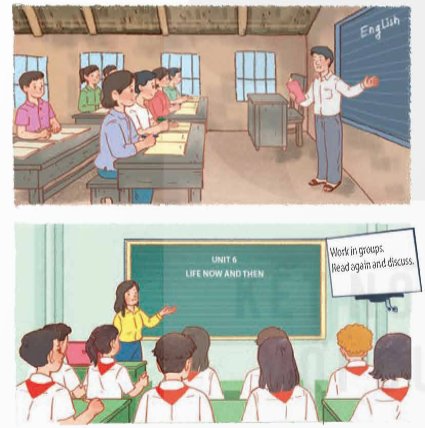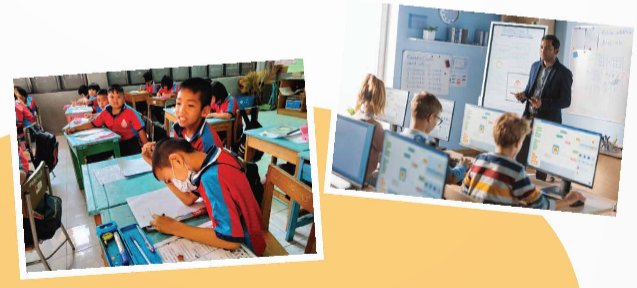Work in groups. Discuss if each of the following phrases describes past or present learning.
- Depending on textbooks
- Using the Internet
- Learning under an oil lamp
- Being independent and active
Work in groups. Discuss if each of the following phrases describes past or present learning.
- Depending on textbooks
- Using the Internet
- Learning under an oil lamp
- Being independent and active
Two people of different generations are talking about their learning styles. Read the passages and choose the correct answer A, B, C, or D.

Mr Nam, grandfather, a 70-year-old farmer
I was one of the few children in my village who was still at school at the age of 15. Every day, I got up early and walked to school. Learning then depended mostly on our teachers and textbooks. We had no library or lab. The nearest bookshop was six kilometres away. I learned simply by taking notes during class, memorising them, and doing the homework. Life then was simple. We rarely travelled outside our village, so we didn't know much about the world around us.
Mai, granddaughter, a 15-year-old student
Learning today is very different from my grandfather's time. It is easier and more convenient. Besides learning from teachers and textbooks, we use the Internet. It provides us with various online sources such as documents, clips, and programmes. Google helps us find the answers to almost any questions we have. The Internet also allows us to pursue our own interests. Learning has become more independent. Although most children in my village have fewer private learning facilities than the students in the city, we are still luckier than my grandfather's generation. We have TVs to watch at home and a library and computers at school.
1. In Mr Nam's time, __________.
A. teachers played an important role
B. there were no bookshops
C. students did experiments in labs
D. all children stayed on at school until they were 15
2. Few people travelled outside their village, so __________.
A. life in the village was simple
B. his school didn't have any learning facilities
C. the villagers didn't know much about the world around
D. none of the villagers knew about city life
3. Learning now __________.
A. does not require textbooks
B. uses some online programmes
C. depends only on the Internet
D. does not require students to take notes
4. The word "It" refers to __________.
A. leaming today
B. my grandfather's time
C. learning facilities
D. the Internet
5. The word "we" refers to __________.
A. learning facilities
B. students at my grandfather's generation
C. students in the city
D. children in the village
Thảo luận (1)Hướng dẫn giải1. A
1. A
2. C
3. B
4. A
5. D
In Mr Nam's time, teachers played an important role.
(Vào thời ông Nam, thầy trò đóng vai trò quan trọng.)
A. teachers played an important role
(giáo viên đóng một vai trò quan trọng)
B. there were no bookshops
(không có hiệu sách)
C. students did experiments in labs
(học sinh đã làm thí nghiệm trong phòng thí nghiệm)
D. all children stayed on at school until they were 15
(tất cả trẻ em ở lại trường cho đến khi chúng 15 tuổi)
Thông tin: Learning then depended mostly on our teachers and textbooks.
(Việc học lúc đó phụ thuộc chủ yếu vào thầy cô và sách giáo khoa.)
2. C
Few people travelled outside their village, so the villagers didn't know much about the world around.
(Rất ít người đi du lịch ra ngoài làng của họ nên dân làng không biết nhiều về thế giới xung quanh.)
A. life in the village was simple
(cuộc sống ở làng rất đơn giản)
B. his school didn't have any learning facilities
(trường học của anh ấy không có bất kỳ cơ sở học tập nào)
C. the villagers didn't know much about the world around
(dân làng không biết nhiều về thế giới xung quanh)
D. none of the villagers knew about city life
(không ai trong làng biết về cuộc sống thành phố)
Thông tin: We rarely travelled outside our village, so we didn't know much about the world around us.
(Chúng tôi hiếm khi đi ra ngoài làng nên không biết nhiều về thế giới xung quanh.)
3. B
Learning now uses some online programmes.
(Việc học hiện nay sử dụng một số chương trình trực tuyến.)
A. does not require textbooks
(không yêu cầu sách giáo khoa)
B. uses some online programmes
(sử dụng một số chương trình trực tuyến)
C. depends only on the Internet
(chỉ phụ thuộc vào Internet)
D. does not require students to take notes
(không yêu cầu học sinh ghi chép)
Thông tin: Besides learning from teachers and textbooks, we use the Internet. It provides us with various online sources such as documents, clips, and programmes.
(Bên cạnh việc học từ giáo viên và sách giáo khoa, chúng ta còn sử dụng Internet. Nó cung cấp cho chúng tôi nhiều nguồn trực tuyến khác nhau như tài liệu, clip và chương trình.)
4. A
The word “It” refers to learning today.
(Từ “It” ám chỉ việc học ngày nay. )
A. learning today
(học tập ngày nay)
B. my grandfather's time
(thời ông tôi)
C. learning facilities
(cơ sở vật chất học tập)
D. the Internet
(mạng Internet)
Thông tin: Learning today is very different from my grandfather's time. It is easier and more convenient.
(Việc học ngày nay rất khác so với thời ông nội tôi. Nó dễ dàng và thuận tiện hơn.)
5. D
The word “we” refers to children in the village.
(Từ “we” dùng để chỉ trẻ em trong làng )
A. learning facilities
(cơ sở vật chất học tập)
B. students at my grandfather's generation
(học sinh ở thế hệ ông nội tôi)
C. students in the city
(học sinh ở thành phố)
D. children in the village
(trẻ em trong làng)
Thông tin: Although most children in my village have fewer private learning facilities than the students in the city, we are still luckier than my grandfather's generation.
(Dù hầu hết trẻ em ở làng tôi có ít cơ sở học tập riêng hơn học sinh thành phố nhưng chúng tôi vẫn may mắn hơn thế hệ ông nội tôi.)
(Trả lời bởi Nguyễn Quốc Đạt)
Fill in each blank with ONE word from the passage.
1. Mr Nam learned mainly from teachers and _______.
2. He learned by _______ the information he got in class.
3. Nowadays, students can learn from _______ online sources.
4. An example of an online source is _______.
5. The Internet helps children _______ their interests.
Thảo luận (1)Hướng dẫn giải
1. textbooks 2. memorising 3. various 4. Google 5. pursue 1. Mr Nam learned mainly from teachers and textbooks.
(Ông Nam học chủ yếu từ giáo viên và sách giáo khoa.)
Thông tin: Learning then depended mostly on our teachers and textbooks.
(Việc học lúc đó phụ thuộc chủ yếu vào thầy cô và sách giáo khoa.)
2. He learned by memorising the information he got in class.
(Ông ấy học bằng cách ghi nhớ những thông tin có được trong lớp.)
Thông tin: I learned simply by taking notes during class, memorising them, and doing the homework.
(Tôi học đơn giản bằng cách ghi chép trong lớp, ghi nhớ và làm bài tập về nhà.)
3. Nowadays, students can learn from various online sources.
(Ngày nay, học sinh có thể học từ nhiều nguồn trực tuyến khác nhau.)
Thông tin: It provides us with various online sources such as documents, clips, and programmes.
(Nó cung cấp cho chúng tôi nhiều nguồn trực tuyến khác nhau như tài liệu, clip và chương trình.)
4. An example of an online source is Google.
(Một ví dụ về nguồn trực tuyến là Google.)
Thông tin: Google helps us find the answers to almost any questions we have.
(Google giúp chúng tôi tìm câu trả lời cho hầu hết mọi câu hỏi mà chúng tôi có.)
5. The Internet helps children pursue their interests.
(Internet giúp trẻ theo đuổi sở thích của mình.)
Thông tin: The Internet also allows us to pursue our own interests.
(Internet cũng cho phép chúng ta theo đuổi sở thích riêng của mình.)
(Trả lời bởi Nguyễn Quốc Đạt)
Work in groups. Discuss and make a list of the changes in your learning over the past five years.
You can mention:
- number of subjects
- teachers
- learning facilities
- learning style (dependent/independent...)
Thảo luận (1)Hướng dẫn giải- number of subjects: more subjects, increased variety, including Literature, Chemistry, Physics, Biology,...
(số lượng môn học: nhiều môn hơn, đa dạng hơn, bao gồm Văn, Hóa, Lý, Sinh,...)
- teachers: each teacher for one specific subject
(giáo viên: mỗi giáo viên phụ trách một môn học cụ thể)
- learning facilities: classrooms are larger, having specialized rooms such as laboratories, music rooms, and art rooms
(cơ sở vật chất học tập: phòng học rộng hơn, có các phòng chuyên biệt như phòng thí nghiệm, phòng âm nhạc, phòng mỹ thuật)
- learning style: more independent learning with self-study and research
(phong cách học tập: học tập độc lập hơn với việc tự học và nghiên cứu)
(Trả lời bởi Nguyễn Quốc Đạt)
Share with the class the list your group has made in 4.

Thảo luận (1)Hướng dẫn giải(Trả lời bởi Nguyễn Quốc Đạt)
Aspects
(Khía cạnh)
5 years ago
(5 năm trước)
Now
(Bây giờ)
Number of subjects
(số lượng môn học)
Fewer subjects, typically core subjects
(Ít môn học hơn, điển hình là các môn học cốt lõi)
More subjects, increased variety, including Literature, Chemistry, Physics, Biology,...
(Nhiều môn học hơn, đa dạng hơn, bao gồm Văn, Hóa, Lý, Sinh,...)
Teachers
(giáo viên)
One teacher for most subjects
(Một giáo viên cho hầu hết các môn học)
Different subject specific teachers for various subjects
(Giáo viên chuyên môn khác nhau cho các môn học khác nhau)
Learning facilities
(cơ sở vật chất học tập)
Basic classroom setup
(Bố trí lớp học cơ bản)
More specialized classrooms like science labs and art rooms
(Các phòng học chuyên biệt hơn như phòng thí nghiệm khoa học và phòng nghệ thuật)
Learning style
(phong cách học)
Dependent learning
(Học tập phụ thuộc)
More independent learning with self-study and research
(Học tập độc lập hơn với việc tự học và nghiên cứu)